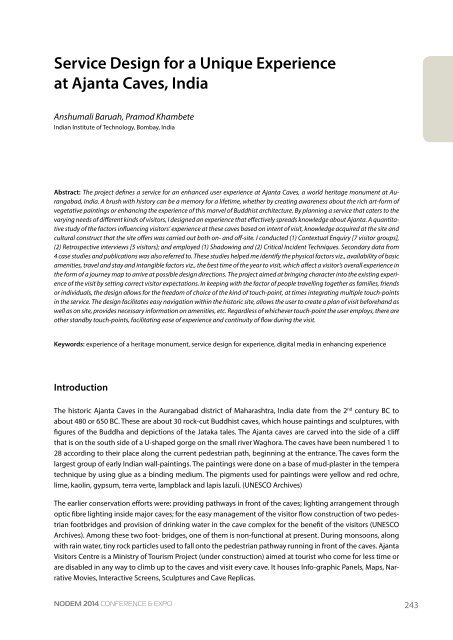NODEM 2014 Proceedings
NODEM 2014 Proceedings
NODEM 2014 Proceedings
Create successful ePaper yourself
Turn your PDF publications into a flip-book with our unique Google optimized e-Paper software.
Service Design for a Unique Experience<br />
at Ajanta Caves, India<br />
Anshumali Baruah, Pramod Khambete<br />
Indian Institute of Technology, Bombay, India<br />
Abstract: The project defines a service for an enhanced user experience at Ajanta Caves, a world heritage monument at Aurangabad,<br />
India. A brush with history can be a memory for a lifetime, whether by creating awareness about the rich art-form of<br />
vegetative paintings or enhancing the experience of this marvel of Buddhist architecture. By planning a service that caters to the<br />
varying needs of different kinds of visitors, I designed an experience that effectively spreads knowledge about Ajanta. A quantitative<br />
study of the factors influencing visitors’ experience at these caves based on intent of visit, knowledge acquired at the site and<br />
cultural construct that the site offers was carried out both on- and off-site. I conducted (1) Contextual Enquiry [7 visitor groups],<br />
(2) Retrospective interviews [5 visitors]; and employed (1) Shadowing and (2) Critical Incident Techniques. Secondary data from<br />
4 case studies and publications was also referred to. These studies helped me identify the physical factors viz., availability of basic<br />
amenities, travel and stay and intangible factors viz., the best time of the year to visit, which affect a visitor’s overall experience in<br />
the form of a journey map to arrive at possible design directions. The project aimed at bringing character into the existing experience<br />
of the visit by setting correct visitor expectations. In keeping with the factor of people travelling together as families, friends<br />
or individuals, the design allows for the freedom of choice of the kind of touch-point, at times integrating multiple touch-points<br />
in the service. The design facilitates easy navigation within the historic site, allows the user to create a plan of visit beforehand as<br />
well as on site, provides necessary information on amenities, etc. Regardless of whichever touch-point the user employs, there are<br />
other standby touch-points, facilitating ease of experience and continuity of flow during the visit.<br />
Keywords: experience of a heritage monument, service design for experience, digital media in enhancing experience<br />
Introduction<br />
The historic Ajanta Caves in the Aurangabad district of Maharashtra, India date from the 2 nd century BC to<br />
about 480 or 650 BC. These are about 30 rock-cut Buddhist caves, which house paintings and sculptures, with<br />
figures of the Buddha and depictions of the Jataka tales. The Ajanta caves are carved into the side of a cliff<br />
that is on the south side of a U-shaped gorge on the small river Waghora. The caves have been numbered 1 to<br />
28 according to their place along the current pedestrian path, beginning at the entrance. The caves form the<br />
largest group of early Indian wall-paintings. The paintings were done on a base of mud-plaster in the tempera<br />
technique by using glue as a binding medium. The pigments used for paintings were yellow and red ochre,<br />
lime, kaolin, gypsum, terra verte, lampblack and lapis lazuli. (UNESCO Archives)<br />
The earlier conservation efforts were: providing pathways in front of the caves; lighting arrangement through<br />
optic fibre lighting inside major caves; for the easy management of the visitor flow construction of two pedestrian<br />
footbridges and provision of drinking water in the cave complex for the benefit of the visitors (UNESCO<br />
Archives). Among these two foot- bridges, one of them is non-functional at present. During monsoons, along<br />
with rain water, tiny rock particles used to fall onto the pedestrian pathway running in front of the caves. Ajanta<br />
Visitors Centre is a Ministry of Tourism Project (under construction) aimed at tourist who come for less time or<br />
are disabled in any way to climb up to the caves and visit every cave. It houses Info-graphic Panels, Maps, Narrative<br />
Movies, Interactive Screens, Sculptures and Cave Replicas.<br />
<strong>NODEM</strong> <strong>2014</strong> Conference & Expo<br />
243


